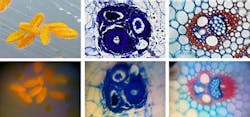iPhone camera turned microscope diagnoses disease
A team of researchers from the University of California-Davis (Davis, CA, USA) has transformed an iPhone into a system that can perform detailed microscopy.
To create the system, UC-Davis physicist Sebastian Wachsmann-Hogiu and his team inserted a 1-mm-diameter ball lens into a hole in a rubber sheet, after which they taped the sheet over the smart phone's camera.
When the $30-$40 lens was paired with the camera, the system could resolve features on the order of 1.5 microns, small enough to identify different types of blood cells.
Because of the nature of the optical pathway through the ball lens, the image captured by the image sensor in the camera is distorted, except for a small spot in its center. The researchers used digital image-processing software to correct for the distortion, and stitched together overlapping images into a single image large enough for analysis.
The researchers believe that the enhanced iPhone could help doctors and nurses diagnose blood diseases in developing nations where many hospitals and rural clinics have limited, or no, access to laboratory equipment.
In addition to bringing new capabilities where they are needed most, the modified phones can also, of course, be used to transmit the images to other medical establishments around the world for further analysis.
-- Posted by Vision Systems Design
BELOW: Stained samples of pollen (left images) and plant stems (right two images). Top row: commercial microscope. Bottom row: cell phone microscope.
